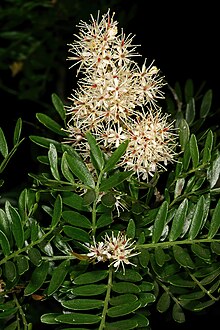
Leucadendron argenteum is an endangered plant species in the family Proteaceae, which is endemic to a small area of the Cape Peninsula, South Africa. Most grow in and around the city of Cape Town, but outlying populations exist near Somerset West (Silwerboomkloof), Paarl and Stellenbosch. It is a protected tree in South Africa.

Atalaya is a genus of eighteen species of trees and shrubs of the plant family Sapindaceae. As of 2013 fourteen species grow naturally in Australia and in neighbouring New Guinea only one endemic species is known to science. Three species are known growing naturally in southern Africa, including two species endemic to South Africa and one species in South Africa, Eswatini and Mozambique.

Protea laurifolia, also known as the grey-leaf sugarbush, is a shrub from South Africa. It is native to the Cape Provinces of South Africa.

Psoralea arborea is a species of legume in the family Fabaceae. It is a shrub or tree endemic to the Cape Provinces of South Africa.

Podocarpus elongatus, the Breede River yellowwood, is a species of conifer in the family Podocarpaceae. In contrast to other yellowwood species of southern Africa, Podocarpus elongatus often resembles an enormous, round, multi-stemmed bush in its habit. The Breede River yellowwood is a protected tree in South Africa.

Greyia flanaganii, commonly known as the Kei bottlebrush, is a species of plant in the Francoaceae family. Greyia flanaganii is one of the related species of the taxonomically isolated and endemic southern African family, the Greyiaceae. Greyia flanaganii is endemic to the Eastern Cape Province of South Africa. It is named after Henry George Flanagan, a South African farmer and botanist from Komga, Eastern Cape, South Africa.
Homalium rufescens is a species of plant in the family Salicaceae. It is endemic to South Africa. It is commonly called the Small-leaved Brown-Ironwood.

Protea comptonii, also known as saddleback sugarbush, is a smallish tree of the genus Protea in the family Proteaceae. It is found in South Africa and Eswatini.

Renosterveld is a term used for one of the major plant communities and vegetation types of the Cape Floristic Region which is located in southwestern and southeastern South Africa, in southernmost Africa. It is an ecoregion of the Mediterranean forests, woodlands, and scrub biome.

Nuxia floribunda, the forest elder, forest nuxia or wild elder, is a species of tree in the Stilbaceae family, that is native to moist regions of southern Africa, East Africa and central tropical Africa.

Cassine peragua, also known as Cape saffron, bastard saffron and forest spoonwood, is a medium-sized tree with fragrant flowers, decorative fruits and a saffron-coloured trunk. It is indigenous to the Afro-montane forests of South Africa.

Acridocarpus natalitius, the moth fruit, is a species of plant in the Malpighiaceae family. It is found in south-eastern Africa.
Colubrina nicholsonii is a species of tree in the family Rhamnaceae. It is a protected species endemic to South Africa. The plant grows in subpopulations in isolated gorges, usually of 10-20 and less than 50 individuals overhanging water. It is estimated that there are no more than 1,000 individuals in the wild.

Nuxia congesta, commonly known as brittle-wood, is a species of tree in the Stilbaceae family, with an extensive range in the Afrotropics. The species is named congesta for its dense inflorescences.

Protea rubropilosa, also known as the Transvaal sugarbush, escarpment sugarbush or Transvaal mountain sugarbush, is a flowering tree, that belongs to the genus Protea in the family Proteaceae. The plant only occurs in South Africa.

Leucadendron conicum, the garden route conebush, is a flower-bearing shrub that belongs to the genus Leucadendron and part of the fynbos form. The plant is native to the Western Cape and the Eastern Cape, where it occurs in the Langeberg, Outeniqua Mountains, Tsitsikamma Mountains, Elandsberg and Garden Route plain.The shrub grows to be 6 m and bears flowers from October to November.

Paranomus tomentosus, the hairy-leaf tree sceptre, is a flower-bearing shrub that belongs to the genus Paranomus and forms part of the fynbos. The plant is native to the Western Cape, South Africa.

Erica caffra is a small tree, sometimes a shrub, that grows in riparian habitats and on forest edges and occurs from the Western Cape to the Drakensberg of KwaZulu-Natal and Lesotho. The tree's flowers look like bells. The tree's national tree number is 572.
The Umtiza Nature Reserve is one of two forest nature reserves in the greater East London Coast Nature Reserve. It is named after Umtiza listeriana, a rare and protected legume found within the reserve. The Buffalo River borders the northern part of the reserve, and includes the remaining Umtiza Forest on the southern banks of the river. The Buffalo Pass traverses the entirety of the reserve and the surrounding Controlled Forest Area.























